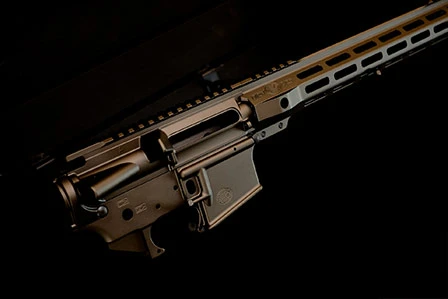AR-15
Unraveling the Complexity of the AR-15 Ejection Pattern: Debunking Myths and Embracing Realities
In the intricate world of firearm mechanics, few phenomena evoke as much scrutiny and speculation as the AR-15 ejection pattern. From casual conversations among enthusiasts to in-depth discussions on specialized forums, misconceptions surrounding how brass behaves after you pull the tripper persist, often leading to unwarranted modifications and unnecessary component swaps. To truly grasp the nuances of the AR-15 ejection pattern, it’s essential to delve deeper into its underlying factors and dispel common myths, all while embracing the realities that govern this critical aspect of AR performance.
Dispelling Common AR-15 Ejection Pattern Misconceptions
Anecdotes and hearsay frequently dominate discussions regarding AR-15 ejection patterns, with enthusiasts quick to attribute deviations in brass trajectory to specific mechanical issues. The simple fact is that things are not quite so simple Statements like “My brass ejects at 1-2 o’clock, indicating over-gassing” or “Brass ejecting at 5 o’clock signals the need for a lighter buffer” are commonplace. However, while brass ejection can indeed serve as a diagnostic indicator, it is far from the sole determinant of a rifle’s operational health.
Does it Run? Understanding Operational Functionality
At the heart of any discussion about the AR-15 ejection pattern lies a fundamental question: Does your gun reliably function as intended? If the answer is affirmative, the necessity for immediate parts replacement is often unwarranted. Conversely, if malfunctions occur, a systematic diagnostic approach is imperative. Is the issue related to firing, extraction, or ejection? By methodically addressing each step of the firing cycle, from routine maintenance to potential magazine issues, many problems can be rectified without resorting to component replacement.

Unraveling the Complexities of AR-15 Ejection Pattern
To truly comprehend the AR-15 ejection pattern, one must consider the myriad factors that influence it. Critical components such as the ejector, extractor, bolt carrier, buffer setup, and buffer spring all exert significant influence over brass behavior. Variables such as the condition of these components, the type of bolt carrier employed, and the weight of the buffer can dramatically alter ejection dynamics. Moreover, the characteristics of the ammunition being used, the degree of barrel wear, and the presence of suppressors introduce additional layers of complexity.
The composition of your bolt assembly plays a pivotal role in determining how your AR-15 ejects brass. An essential component to consider is the ejector and its accompanying spring nestled within your bolt. When a brand new spring is introduced, it operates differently compared to one that has undergone numerous compression cycles. The stiffness of a new spring prompts a more vigorous ejection of casings, while a well-worn spring may result in a softer, less forceful ejection. Conversely, instances where an ejector breaks in two, albeit aligning the pieces, can yield a noticeably mushy ejection until rectified with a replacement.
Similarly, the condition of your extractor and its spring influences ejection dynamics. A new extractor boasting a sharp claw will securely latch onto brass rims with increased force, facilitating harder ejections compared to a worn extractor. Conversely, a dull extractor lacking proper teeth on its outer edges may prompt ejections at varying angles, impacting the AR-15 ejection pattern.
Moving beyond the bolt, the choice of bolt carrier also exerts a significant influence on ejection patterns. Full auto carriers, distinguished by their heavier build, typically prompt ejections in front of the shooter, typically between the 1-3 o’clock range. Conversely, low mass carriers, designed for reduced weight, often yield ejections towards the 4-6 o’clock range. It’s worth noting that while bolt carriers play a crucial role, other bolt components still wield influence over ejection dynamics, even with different carrier types.
Dirty Bird Industries Enhanced Bolt Carrier Group .223/5.56
$149.95
Dirty Bird Guns & Ammo
 View Details
View Details
Moreover, low-mass bolt carrier groups predominantly find application in competition firearms meticulously tuned to specific loads. These setups, meticulously calibrated to shave ounces off race guns, often incorporate specialized buffer configurations and occasionally employ adjustable gas blocks. Such tuned firearms operate within exceedingly narrow parameters to achieve desired outcomes.
JP Enterprises Aluminum Ultra Low Mass Bolt Carrier w/ Titanium Firing Pin & Gas Ring
$349.95
AR15Discounts.com
 View Details
View Details
Buffer setups further contribute to ejection characteristics. A lighter-than-optimal buffer may prompt rearward ejections, yet unless the rifle experiences short-stroking, functionality remains intact. Conversely, a heavier buffer typically yields forward ejections. However, the critical question remains: is the rifle functioning reliably? Unless the bolt outpaces the seating of the subsequent round, the ejection pattern, while potentially suboptimal, may not necessarily signify a functional issue.
AR-15 Ejection Pattern – Navigating the Reality of Variability
A closer examination reveals the stark reality that the AR-15 ejection pattern is subject to a multitude of influences, each contributing to its unique behavior. Factors such as wear patterns, spring tension variations, ammunition quality discrepancies, and barrel erosion rates all play pivotal roles. While the pursuit of optimal performance is undoubtedly a noble endeavor, it must be tempered by pragmatism. Ultimately, ensuring the rifle’s unwavering reliability under diverse conditions should take precedence over chasing marginal improvements based solely on ejection dynamics. In layman’s terms, if it ain’t broke, we’d be hesitant to go chasing to “fix” an AR-15 ejection pattern simply because someone one on an internet forum said so.
Conclusion: Embracing Knowledge and Pragmatism
In conclusion, unraveling the complexities of the AR-15 ejection pattern requires a blend of knowledge, experience, and pragmatism. While myths and misconceptions abound, understanding rooted in the rifle’s operational principles is important. Rather than blindly adhering to internet conjecture, nothing replaces hands-on testing and diagnostics to ascertain genuine performance needs. Remember, the true measure of a firearm’s worth lies not in the trajectory of ejected brass but in its consistent and reliable function when it matters.
 Dirty Bird Brand AR-15 Parts
Dirty Bird Brand AR-15 Parts